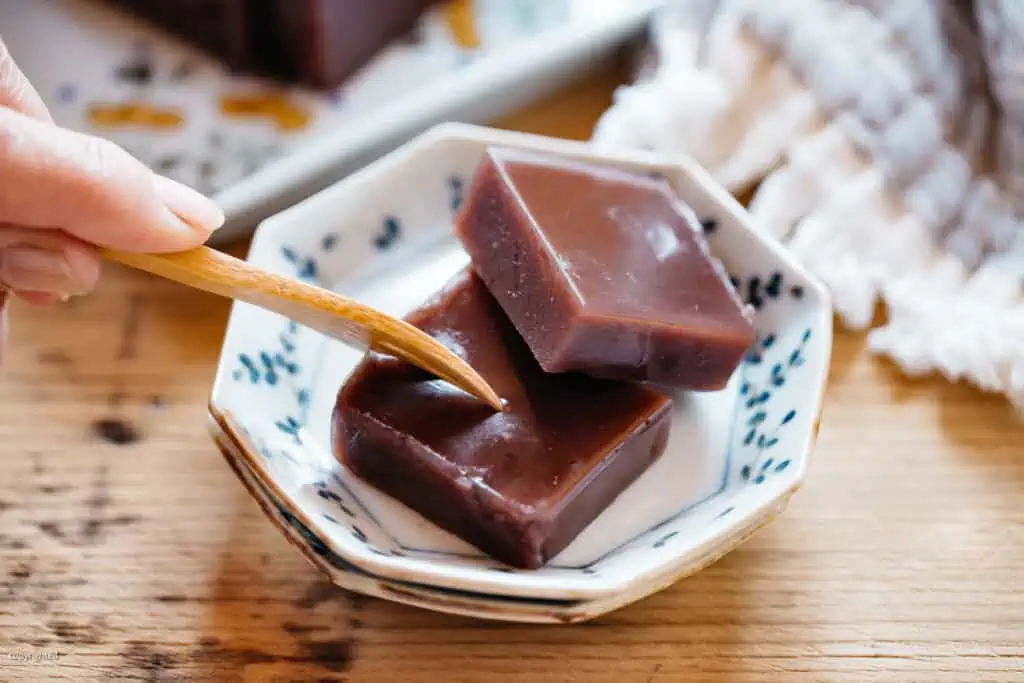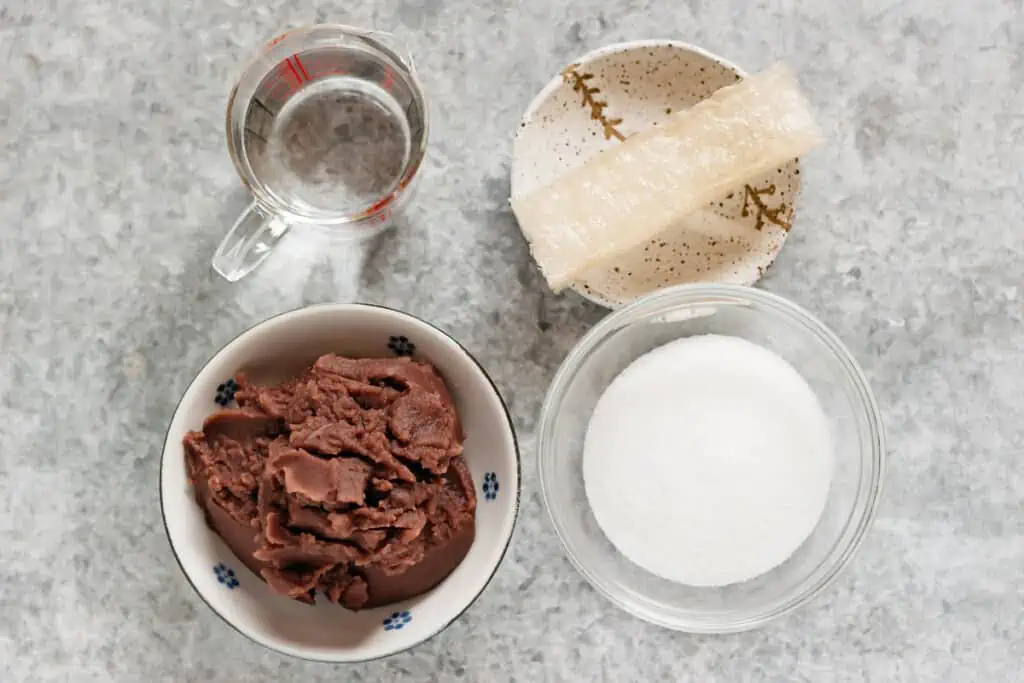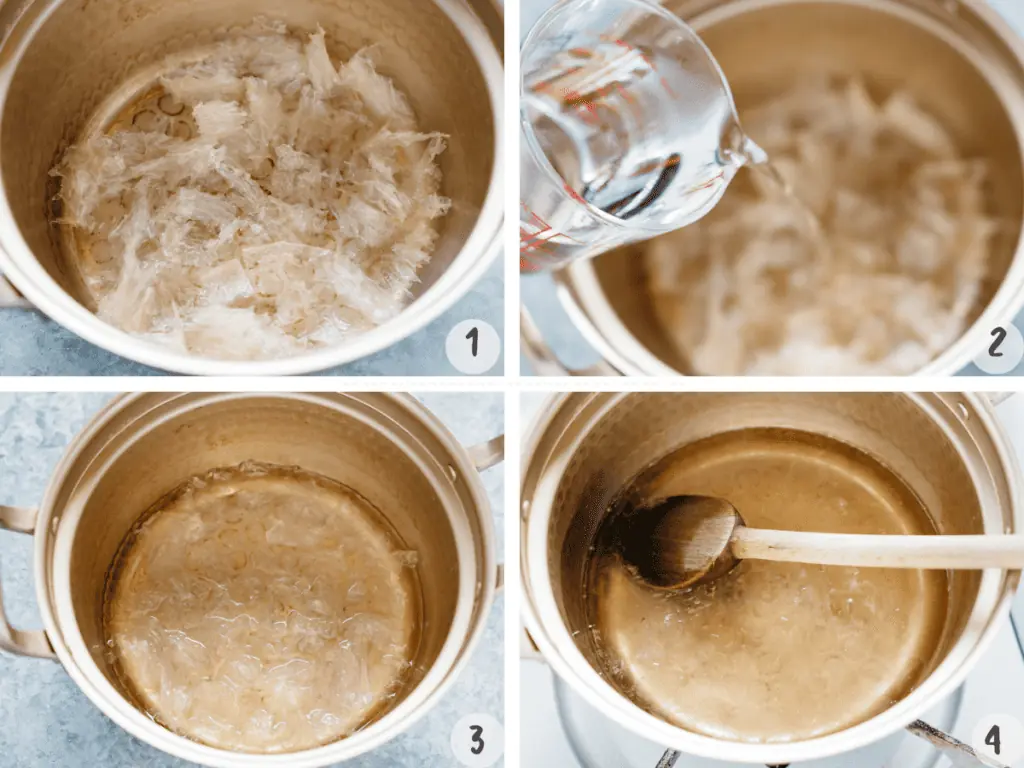Looking for a sweet treat that’s steeped in history and cultural significance? Look no further than yokan! This traditional Japanese dessert has been delighting taste buds for centuries, thanks to its unique texture, subtle sweetness, and fascinating backstory. This tasty little sweet is made from azuki beans, sugar, and kanten (a jelly-like substance derived from seaweed) making it perfectly suitable for vegans. With it’s unique firm yet squishy texture and subtle sweetness, yokan is a must-try for anyone looking to expand their culinary horizons.
Table of contents
What is Yokan
Yokan is a traditional Japanese sweet that has been enjoyed for centuries. It is a type of wagashi, or traditional confectionery, that is typically made from azuki beans paste called “Anko“, sugar, and Kanten. This jelly-like dessert is known for its smooth texture and subtle sweetness, making it a popular treat in Japan and around the world. It’s often sold in a block or individual slices and eaten with a little stick. There are many variations of this delightful treat with some containing fillings like chestnuts, flavoured with things like matcha or sakura, or prepared differently by being steamed (mushi yokan) or made with extra water (mizu yokan). Every adaptation over the years has added something special to this already delicious and well loved dessert.
Yokan History and cultural significance
Yokan, the sweet red bean jelly that has captured the hearts of many across Japan and beyond, is more than just a dessert. It’s a cultural icon with a rich history dating back centuries. The origins of yokan can be traced back to the Kamakura-Muromachi period (between 1185-1573). The monks of Buddhism introduced Chinese confectionary made by boiling sheep meat gelatin. However monks were not allowed to eat meat so they made a vegetarian version with azuki beans and Kanten agar-agar. Over time, yokan became popular among all social classes and was even used as an offering during tea ceremonies. The dessert’s simple yet elegant appearance and its subtle sweetness soon became associated with hospitality and refinement. Today, yokan continues to hold cultural significance in Japanese society and is a popular sweet treat sold in every shop.
Different types of Yokan
There are mainly three different types of Yokan in Japan: Neri-Yokan, Mizu-Yokan, and Mushi-Yokan. Each one has a different taste and texture.
Neri Yokan
In general, when Japanese say “Yokan” they are referring to this type of Yokan. It has a firm yet squishy and smooth texture that melts in your mouth. It has a subtle sweetness that goes well with the bitterness of rich matcha green tea.
Mizu Yokan
This literally translates to “water yokan.” It is made from the same ingredients as Neri Yokan but it has a higher water content and less kanten, resulting in a lighter colour with a smoother and jelly-like plump texture. Mizu yokan often has additional ingredients like chestnuts or green tea for added flavour. It is a perfect Japanese summer sweet.
Mushi Yokan
Mushi means steamed in Japanese, so mushi yokan is steamed yokan. Because this yokan is made differently, the ingredients also differ from Neri and Mizu yokan. Wheat flour is used instead of kanten agar powder making it have a springy and chewy texture. Mushi yokan also does not last as long as neri and mizu yokan.
Variations and adaptations made to the original recipe
A popular and common variation is on yokan is to swap some of the ingredients such as tsubuan instead of koshian. Shiroan, which is made from white kidney beans, can also be used instead of red bean paste If shiroan is used, other flavours such as matcha can be added to the yokan. Bits of sweet potatoes or kuri chestnuts can also be added as a tasty variation. A more recent adaptation that became popular is “Anmitsu yokan“. This hybrid sweet combines two classic Japanese confections: yokan and anmitsu.
One interesting fact about yokan is that it comes in different flavours depending on the region where it is made. In Kyoto, they have matcha-flavored yokan while in Hokkaido they make it with local ingredients like milk and potatoes. If you’re ever in Japan, don’t miss out on trying this scrumptious treat! Whether you’re enjoying it alone or with friends over tea, Yokan will certainly leave a lasting impression on your taste buds.
Ingredients required to make yokan
Koshian – First on the list is koshian azuki bean paste. This sweet and creamy paste is made from simmered and mashed azuki beans, which are commonly used in Japanese sweets. The koshian variety has been strained to remove all of the skins, resulting in the signature smooth texture of yokan. You can buy ready made Koshian from Japanese grocery stores or online stores. If you can’t access those, you can make your own from scratch following this recipe.
Kanten – Kanten (or agar agar) is a jelly-like substance derived from seaweed and acts as a natural thickener. When mixed with water and boiled, it solidifies into a gelatin form to give yokan its firm texture. I used Bō Kanten.
Sugar – Yokan requires sugar to balance out the earthy flavours of the beans and agar agar and make the treat taste sweet. But its a subtle sweetness that isn’t overwhelmingly sweet.
Water – Water helps to dissolve the sugar and kanten, creating a smooth mixture that can be poured into molds or cut into slices once set.
How to make Yokan
- Put the yokan and water in a small saucepan and soak for about half an hour. (You don’t need to soak if you use kanten powder).
- After it has soaked, place the pan over medium-high heat to bring it to boil. Whisk the mixture well. Turn the heat down to low, continue whisking and let it simmer for at least a minute until the kanten dissolves completely.
- Add sugar to the mixture and stir until it’s fully incorporated.
- Stir Koshian in until it’s well combined and thickened, scoop it up with a spatula and if it is about 2mm thick and flows, turn the heat off.
- Pour the mixture into a rectangular container. In Japan we use one that is called “nagashikan” in Japanese. My nagashikan size is 5.5 x 4.3 x 1.9 inches (140 x 110 x 47cm)
- Chill in the fridge for about 2 hours.
How is yokan served?
In Japan, yokan is typically served in small rectangular shapes and sliced into bite-sized pieces. It can be eaten as a snack or served alongside green tea during a traditional Japanese tea ceremony. Some people also enjoy pairing it with ice cream or other sweets to balance out the dessert. It is also often gifted during special occasions such as weddings. Toraya is a famous brand for Yokan in Japan that can be found in Tokyo.
Tips for Making Yokan
- Are you tired of your Yokan not turning out exactly the way you want it to? There’s no need to worry because I have some tips and tricks that will help perfect your Yokan recipe!
- Firstly, it’s important to use high-quality ingredients. The flavor and texture of your Yokan will greatly depend on the quality of the ingredients used. So make sure you are using good quality kanten powder, sugar, and beans.
- When cooking with kanten powder, be sure to follow the instructions carefully. It is important to dissolve it completely before adding any other ingredients. If you don’t do this properly, your Yokan may turn out lumpy or have a weird texture. So once the Kanten has dissolved, keep simmering for at least one minute more.
FAQ
A : Yokan is written in Japanese as 羊羹, which literally translates to “sheep cake”. You may be wondering why a sheep has anything to do with this scrumptious dessert. Well, it all goes back to the time in Japan. If you are interested, read the history part above.
A : It will store for a few days in the fridge. Slice it in portion size and wrap with cling wrap individually then place in a ziplock bag. It will keep for a month in the freezer.

Yokan
Ingredients
- 400 g Koshian
- 130 g sugar
- half Bō(stick) Kanten *1
- 200 ml water
Instructions
- Put the yokan and water in a small saucepan and soak for about half an hour. *2
- After it has soaked, place the pan over medium-high heat to bring it to boil. Whisk the mixture well.
- Turn the heat down to low, continue whisking and let it simmer for at least a minute until the kanten dissolves completely.
- Add sugar to the mixture and stir until it's fully incorporated.
- Stir Koshian in until it's well combined and thickened, scoop it up with a spatula and if it is about 2mm thick and flows, turn the heat off.
- Pour the mixture into a rectangular container. In Japan we use one that is called "nagashikan" in Japanese. *3
- Chill in the fridge for about 2 hours.
- Slice to serve.









Very simple to follow and makes a nice yokan
Thank you Richard for making Yokan with my recipe 😀
Made yokan today as it is one of my favorite Japanese sweets and this recipe is great!
That’s fantastic, Thank you Maxwell 😀